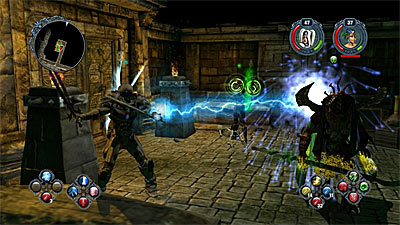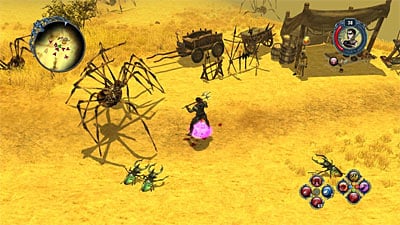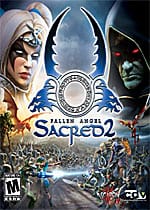Found in Translation?
Hack ‘n slash dungeon-crawls are usually best left to the PC. After all, even Diablo, the genre-defining franchise, made one incursion onto the original PlayStation with mixed results – wisely, the upcoming Diablo III will be a PC-exclusive. That being the case, Sacred 2: Fallen Angel, a series very much made in the Diablo mold, may just be a better game on consoles than it was on Windows-based platforms. Though technically not particularly well-executed, the scope and ease of co-op play along with a mostly-solid control scheme make Sacred 2: Fallen Angel a very enjoyable experience that any console RPG enthusiast will enjoy.

Sacred 2: Fallen Angel takes players back to the world of Ancaria some 2,000 years before the events of the original game. Ancaria is a realm transformed by the taint of T-energy; a magical, glowing fluid that can be harnessed for good or ill. Much like Prometheus’ act of giving fire to humans from Greek mythology, the Seraphim (female, elven-like paragons) gave knowledge of this power to the High Elves. Though T-energy makes a host of wonders possible, it is also a potentially destructive force. In fact, it caused the High elves to split up and hoard the energy from other races as well as cause the creation of horrible monsters throughout the land. Choosing from one of several classes and a two-sided campaign, players will fight to push the world of Ancaria toward the path of light or shadow through their heroic or nefarious deeds.
Unfortunately, the general narrative is far more interesting than the individual missions and specific quests with which you will partake. In fact, mashing your way through text bubbles and crude cinematics is part and parcel of Sacred 2. This game truly is a hack ‘n slash, but, outside of combat, it never engages the player with specific quests that truly bolsters the overarching storyline. I’ve got a feeling this is due to the openness of the game. Rather than telling a compelling story through one hero, players are given freedom to make their own way through the game from the perspective of various factions on disparate sides of the conflict. While this seems like a great idea at the onset – who wants to be railroaded nowadays – it’s left wanting for greater craft. As such, it never creates a story that matters.
Nevertheless, a lot of choice and options are built into the game; this allows players to craft their own experience. While the Seraphim walk the path of light, Inquisitors are evil priests that stop at nothing to carry out their plans. Players can also choose from four other classes including the High Elf, Dryad, Shadow Warrior, and Temple Guardians. All classes are distinct, with the jackal-like robot Temple Guardians being the most bizarre. As alluded to previously, your class selection will determine how the game plays out, as the stories are tailored to each. Additionally, each character can choose from several deities, which influences the kinds of powers and combat abilities that will become available to them. Though the story seems to be hampered by this design choice, getting to create your own adventure is still rewarding.

Combat in Sacred 2 is addictive and satisfying, though decidedly repetitive – this is a dungeon-crawling hack ‘n slash, after all. Consequently, players will roam around the incredibly vast world, beating upon myriad beasties. Thankfully, this is done with the greatest of ease. While the PC version of the game utilized genre-standard clicks-of-death controls, this repetition was shunned by the developers for the console versions in favor of held button presses. As a result, rather than turning into a frenzied button-masher, players can calmly maintain a face button depressed until the beasties are dead. Moreover, attacks are easily varied by simply pressing on a different face button. The game uses a power and item mapping system that allows the player to assign their favorite skills and utilities to the buttons and the D-pad for instant access. By simply selecting a function key on the controller, additional slots are opened up, allowing players access to a total of 16 power and item slots. This simple control scheme makes Sacred 2 generally more enjoyable to play than it was on PC. However, area of effect and targeted spell powers are far more cumbersome. That’s because you’ll have to guide your spells with the left analog stick toward enemies that are constantly moving – it gets to be quite annoying, especially during boss battles.
Speaking of bosses, Sacred 2 does a nice job of mixing up the critters and the challenges they present throughout the game. Most caverns, dungeons, and fortifications are populated by a host of minions that are little more than walking loot drops. However, make your way to the end of the labyrinth, and you’ll be confronted by a mini-boss or BBG that can be truly deadly. This mix makes you feel both heroic and tested at the same time. What’s more, the character design and the sheer number of baddies are delightful. Making your way through countless miles of perilous terrain will reveal a host of monsters few other games can match.

In addition to varied enemies, players will also find great power progression tools and a ton of loot. Advancing in levels, opening up combat abilities, and generally making your character badass is both intuitive and rewarding. Also, the number of items found in Sacred 2 is outstanding. Even at the lowest levels, players will find lots of goodies that will buff their character.

I loved the fact there were so many body slots with which to deck out my characters; from rings and helms to gauntlets, mail, and weaponry, Sacred 2 is a loot-junky’s paradise. Furthermore, rather than having to sell off unusable rare items for a pittance in comparison to the value of their utility, players can drop goods into chests located in convenient places around the realm. Later, you can roll up a second, third, or fourth character, hop into the campaign, and get access to the items with a class that can make use of them. This leads to another of the game’s great strengths.
Hopping in and out of the single-player campaign with different characters is a breeze. It also lets you see the game from all of the faction perspectives and adds additional replay value to a game that is already hundreds of hours in length. Taking it to the next level, multiplayer support is every bit as well implemented. Players from all around the world can easily jump in and out of each other’s games. The system for filtering who can join is a snap, and venturing with a party of four into scaled campaign quests is a ton of fun. Also, if you die, you’ll be able to quickly warp to where you last left your party. While this may not seem realistic, it gets you back into the action with your buddies in no time – a smart design move that keeps the fun going.
Presentation in Sacred 2 is truly a mixed bag. The environments, for example, are beautiful. However, the cinematics are crude, the action often drags with multiple enemies on screen, and screen-tearing is a persistent problem. As with the initial launch of the PC version, Sacred 2: Fallen Angel is plagued by a host of technical issues out of the box. Furthermore, voice over work is quite poor. This is less to do with actor performance (though it is overly dramatic) and more a problem with horrendous lip syncing, repetitive catchphrases, and poorly written dialogue. Graciously, the background and theme music is very good. German fantasy metal band Blind Guardian lend their stylings to the title, which fit perfectly with the mood and atmosphere of the game.
Is Sacred 2: Fallen Angel for home consoles the definitive version of the game? I guess that depends on whether you consider yourself a PC or console gamer. Though the console version seems to generally improve upon the game’s controls, it also is visually less impressive than the PC title and is technically behind the curve – loads of patches have fixed a lot of problems with the PC outing. Nonetheless, whichever platform you choose, you won’t be disappointed with the hack ‘n slash goodness the game provides – even if you’ve done it all before.
RATING OUT OF 5 RATING DESCRIPTION 3.7 Graphics
While the world is beautiful and the enemies are varied, constant technical issues hold the title back. 4.0 Control
Controls are tight, as the power and item mapping works great with a console controller. Also, incessant clicking has been done away with. Too bad the use of certain combat abilities such as spells can be trying. 3.5 Music / Sound FX / Voice Acting
This game’s repetitive catchphrases and meager dialogue are made up for by the BGM and musical theme. 3.9 Play Value
Though the game does nothing to move the genre forward, what it does it does well. There are hundreds of hours of gameplay both on and offline should you so choose. 3.8 Overall Rating – Good
Not an average. See Rating legend above for a final score breakdown.
Game Features:
